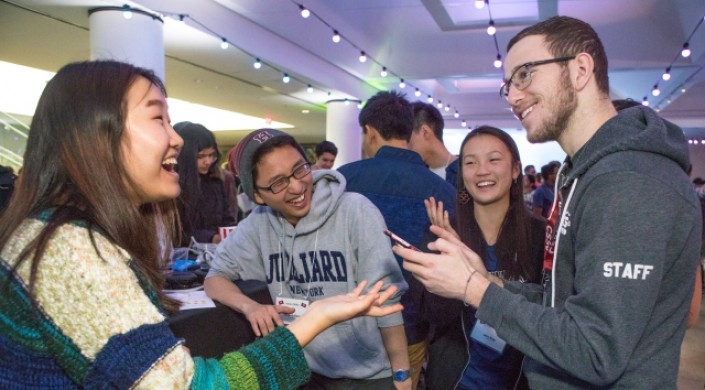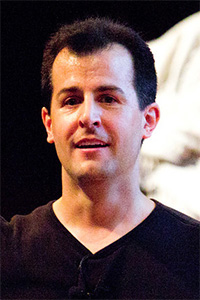News
Freshmen Amy Zhou, Sang-O Park, and Jess Eng explain their weather and apparel app, Thunderwear, to teaching fellow Miles Fertel, A.B. '19, a computer science concentrator, during the CS50 Fair. (Photo by Eliza Grinnell/SEAS Communications.)
Whether practical or whimsical, altruistic or futuristic, the student projects on display at the annual Introduction to Computer Science (CS50) Fair had one thing in common: creativity.
During the annual fair, student teams show off web or mobile applications that are the culminating pieces of this introductory John A. Paulson School of Engineering and Applied Sciences computer science course. One of the most popular courses at Harvard, CS50 drew more than 600 undergraduates from a wide range of concentrations. The projects students created were as varied as their backgrounds and interests.
(From left) Freshmen Amy Zhou, Jess Eng, and Sang-O Park created an app to help users dress appropriately for the weather. (Photo by Eliza Grinnell/SEAS Communications.)
Thunderwear
Created by freshmen Amy Zhou, Jess Eng, and Sang-O Park
A quick glance at the morning weather forecast might leave one out in the cold if temperatures shift over the course of the day. Thunderwear allows users to input any location in the world and immediately receive an outfit recommendation, based on the next 12 hours of weather data. The goal is to help people be more efficient while they hurry to get dressed in the morning, Zhou said. The students’ prototype offers a limited number of clothing choices, but they hope to add additional garments and also let users customize temperature and clothing preferences.
“When I glance at the weather, the first thing that pops out is the highs and lows, neither of those temperatures is indicative of what you should be wearing for the entire day,” Park said. “This app allows you to plan more efficiently.”
Visiting undergraduate student Diana Schoeller and economics concentrator Philipp Schellhaas, A.B. '20, hope the microlending platform they created helps spur development in South African villages. (Photo by Eliza Grinnell/SEAS Communications.)
SimpLending
Created by Philipp Schellhaas, A.B. ’20, an economics concentrator, and Diana Schoeller, a visiting undergraduate student
In South Africa, most lenders live near major cities and individuals living in distant rural areas often struggle to access capital for business projects. With SimpLending, these students created a peer-to-peer lending platform designed to bring borrowers and lenders together. Borrowers submit detailed information about their projects, and then potential lenders can search for projects to fund by topic or location, Schellhaas explained. Borrowers can also find potential lenders based on the amount of money they have to invest and past projects they’ve funded.
“There is an information gap between investors and rural borrowers in South Africa,” he said. “Our goal is to increase the access to capital for rural South Africans to help promote development in these villages. We wanted to do something that would make an impact.”
(From left) Statistics concentrators Kelvin Wang, A.B. '19, and Genty Daku, A.B. '20, are trying to simplify the complicated world of cryptocurrency. (Photo by Eliza Grinnell/SEAS Communications.)
Bitcoin Bro
Created by Genty Daku, A.B. ’20, and Kelvin Wang, A.B. ’19, both statistics concentrators
With Bitcoin prices recently surging past $17,000, the popularity of cryptocurrency as an investment option is ballooning. To help users navigate the ever-changing cryptocurrency landscape, Daku and Wang developed an online cryptocurrency screener and portfolio manager. Their user-friendly dashboard enables investors to compare price data on different coins, monitor coins in their portfolios through dynamically updating price information, and read the latest news on their favorite coins. The project taught Daku that building a good website involves paying close attention to both back-end data gathering and front-end usability.
“Many people have gotten into cryptocurrency because prices have exploded over the past few months. Realistically, this is probably a bubble, but no one really knows when the bubble is going to burst,” Daku said. “This is a really interesting space and the technology could be revolutionary. Anything could happen in the next few years.”
(From left) Computer science concentrators Isaac Struhl, A.B. '21 and Hong-Long Nguyen, A.B. '21, and Alex Wolff, S.B. '21, an electrical engineering concentrator, are using augmented reality to help students identify peers. (Photo by Eliza Grinnell/SEAS Communications.)
ARrec
Created by Alex Wolff, S.B. ’21, an electrical engineering concentrator, Hong-Long Nguyen, A.B. ’21, a computer science concentrator, and Isaac Struhl, A.B. ’21, a computer science concentrator
Having trouble putting faces with names? These students created an app that can help. ARec is an augmented reality platform that uses facial recognition software to identify a Harvard student by name. Using images captured by an iPhone camera, the app creates a vectorization of an individual’s face. Then a neural network compares that information to all the images in the Harvard College Facebook before identifying the best match. The biggest challenge they faced was setting up the neural net to run efficiently in real-time on an iPhone with limited CPU power, Struhl said.
“We thought it would be really cool, if you forgot someone’s name during opening days, for instance, to just be able to pan your phone across a room and see what someone’s name is,” Struhl said. “It could be useful for a lot of different situations.”
The web app developed by applied math concentrators Katherine Deng, A.B. ’21, and Pratap Singh, A.B. ’21 is designed to break down language barriers. (Photo by Eliza Grinnell/SEAS Communications.)
InterCHATional Chat
Created by Katherine Deng, A.B. ’21, and Pratap Singh, A.B. ’21, applied math concentrators
These students are using technology to break down language barriers. Their web application is a multi-language chat room in which users can send and receive messages in their own languages. Users type in a message, which is then run through Google to instantly translate it into all the languages of users who are connected to the chat room. Each person then receives the message in his or her language. The application, which can create messages in all 104 languages available in Google, helps facilitate conversation by eliminating the need for users to manually translate messages.
“We both have family who speak different languages, so we thought it would be useful to communicate with people without having to worry about language barriers and the issues that come with that,” Singh said. “Especially because Google translate and machine translation services are getting better and better, we are hoping that soon the tech gets good enough that the translation is essentially perfect.”
Topics: Computer Science, Events
Cutting-edge science delivered direct to your inbox.
Join the Harvard SEAS mailing list.
Scientist Profiles
David J. Malan
Gordon McKay Professor of the Practice of Computer Science
Press Contact
Adam Zewe | 617-496-5878 | azewe@seas.harvard.edu




